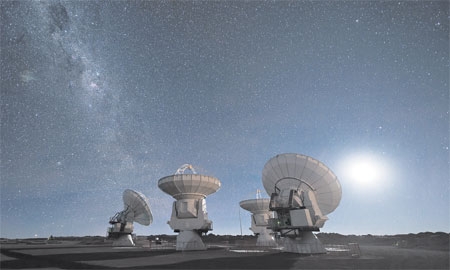The clear skies of northern Chile are among the best in the world for astronomers. The dark, unpolluted and exceptionally transparent atmosphere above the dry, cloudless Atacama Desert creates ideal conditions for stargazing. Around Coquimbo, for example, there are 345 clear nights per year. As a result, the region has become home to some of the most advanced optical astronomical installations on Earth and draws astronomers, engineers, photographers, tourists, students and teachers from around the globe in search of unsurpassable views of heavenly bodies such as the Magellanic Clouds, Southern Cross and the spectacular Milky Way.
Chile has attracted some of the most important astrophysical organizations in the world that, in partnership with the Chilean government and researchers, have developed one of the largest concentrations of international observatories in the world. For example, around 310 miles north of Santiago is the Cerro Tololo Inter-American Observatory (CTIO), and located at an elevation of 16,400 feet in Llano de Chajnantor is the Atacama Large Millimeter Array (ALMA), an international collaboration between Europe, North America and Japan, which is one of the highest astronomical observatory sites in the world and the largest ground-based astronomy project in existence.
The ALMA project is overseen by the European Southern Observatory, ESO – the foremost intergovernmental astronomy organization in Europe – and provides state-of-the-art research facilities for astronomers and astrophysicists.
In Chile, ESO operates three unique world-class sites in the Atacama Desert region at La Silla, Paranal and Llano de Chajnantor.
ESO’s first foray into Chile was at La Silla, a 7,874 foot-high mountain around 370 miles north of Santiago de Chile. The observatory is equipped with several optical telescopes featuring mirror diameters of up to 11.8 feet. Its 11.5-foot New Technology Telescope (NTT) was inaugurated in 1989 and broke new ground for telescope engineering and design. It was the first in the world to have a computer-controlled main mirror – a technology developed at ESO and now applied to most of the world’s current large telescopes, such as ESO’s Very Large Telescope (VLT), the world’s most advanced visible-light astronomical observatory, and VISTA, the world’s largest survey telescope, both at Cerro Paranal.
The technology will also be used at ESO’s latest project 12.5 miles from Cerro Paranal to create the “world’s biggest eye on the sky” on the 10,040-foot Cerro Armazones mountain. Last year, the ESO Council selected Cerro Armazones as the baseline site for the planned 138-foot European Extremely Large Telescope (E-ELT). Construction of the US$1.45-billion E-ELT project is expected to begin in 2012 and operations are slated to begin early in the next decade.
Increasingly, tourists are venturing to Chile to see these cutting-edge facilities and spectacular skies for themselves, and several local communities have responded to this opportunity by building small public observatories to bolster further “astrotourism.”

0 COMMENTS